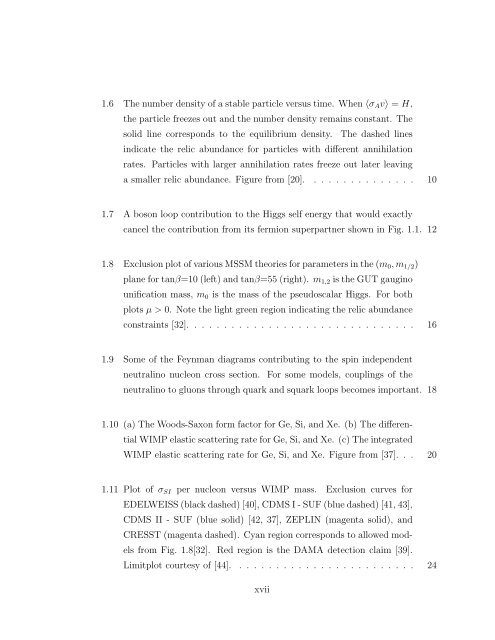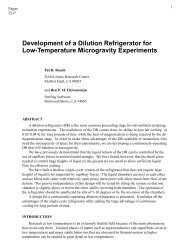cdms-ii - CDMS Experiment - University of California, Berkeley
cdms-ii - CDMS Experiment - University of California, Berkeley
cdms-ii - CDMS Experiment - University of California, Berkeley
You also want an ePaper? Increase the reach of your titles
YUMPU automatically turns print PDFs into web optimized ePapers that Google loves.
1.6 The number density <strong>of</strong> a stable particle versus time. When 〈σ A v〉 = H,<br />
the particle freezes out and the number density remains constant. The<br />
solid line corresponds to the equilibrium density. The dashed lines<br />
indicate the relic abundance for particles with different annihilation<br />
rates. Particles with larger annihilation rates freeze out later leaving<br />
a smaller relic abundance. Figure from [20]. . . . . . . . . . . . . . . 10<br />
1.7 A boson loop contribution to the Higgs self energy that would exactly<br />
cancel the contribution from its fermion superpartner shown in Fig. 1.1. 12<br />
1.8 Exclusion plot <strong>of</strong> various MSSM theories for parameters in the (m 0 , m 1/2 )<br />
plane for tanβ=10 (left) and tanβ=55 (right). m 1,2 is the GUT gaugino<br />
unification mass, m 0 is the mass <strong>of</strong> the pseudoscalar Higgs. For both<br />
plots µ > 0. Note the light green region indicating the relic abundance<br />
constraints [32]. . . . . . . . . . . . . . . . . . . . . . . . . . . . . . . 16<br />
1.9 Some <strong>of</strong> the Feynman diagrams contributing to the spin independent<br />
neutralino nucleon cross section. For some models, couplings <strong>of</strong> the<br />
neutralino to gluons through quark and squark loops becomes important. 18<br />
1.10 (a) The Woods-Saxon form factor for Ge, Si, and Xe. (b) The differential<br />
WIMP elastic scattering rate for Ge, Si, and Xe. (c) The integrated<br />
WIMP elastic scattering rate for Ge, Si, and Xe. Figure from [37]. . . 20<br />
1.11 Plot <strong>of</strong> σ SI per nucleon versus WIMP mass. Exclusion curves for<br />
EDELWEISS (black dashed) [40], <strong>CDMS</strong> I - SUF (blue dashed) [41, 43],<br />
<strong>CDMS</strong> II - SUF (blue solid) [42, 37], ZEPLIN (magenta solid), and<br />
CRESST (magenta dashed). Cyan region corresponds to allowed models<br />
from Fig. 1.8[32]. Red region is the DAMA detection claim [39].<br />
Limitplot courtesy <strong>of</strong> [44]. . . . . . . . . . . . . . . . . . . . . . . . . 24<br />
xv<strong>ii</strong>




